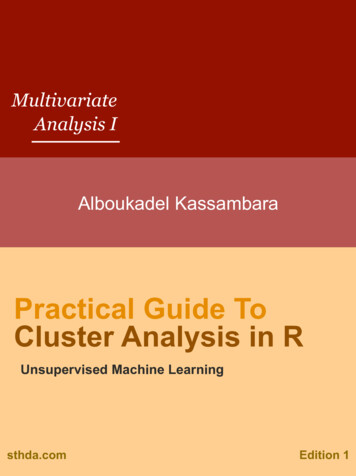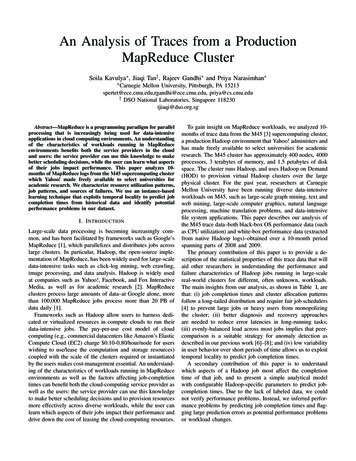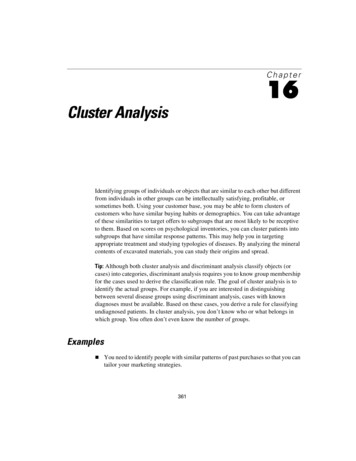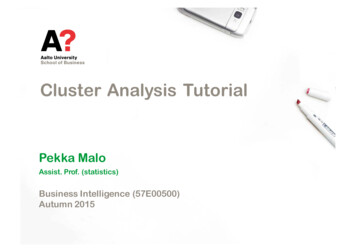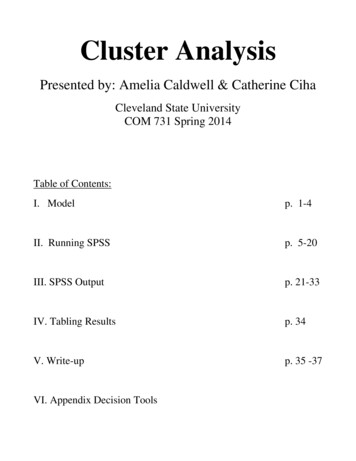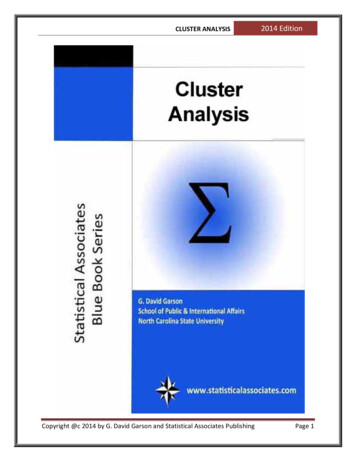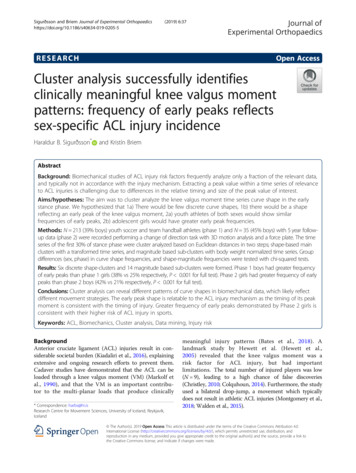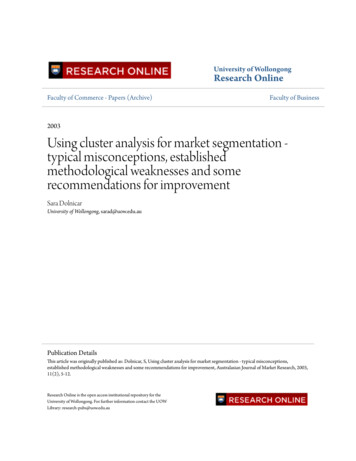
Transcription
University of WollongongResearch OnlineFaculty of Commerce - Papers (Archive)Faculty of Business2003Using cluster analysis for market segmentation typical misconceptions, establishedmethodological weaknesses and somerecommendations for improvementSara DolnicarUniversity of Wollongong, sarad@uow.edu.auPublication DetailsThis article was originally published as: Dolnicar, S, Using cluster analysis for market segmentation - typical misconceptions,established methodological weaknesses and some recommendations for improvement, Australasian Journal of Market Research, 2003,11(2), 5-12.Research Online is the open access institutional repository for theUniversity of Wollongong. For further information contact the UOWLibrary: research-pubs@uow.edu.au
Using cluster analysis for market segmentation - typical misconceptions,established methodological weaknesses and some recommendations forimprovementAbstractDespite the wide variety of techniques available for grouping individuals into market segments on the basis ofmultivariate survey information, clustering remains the most popular and most widely applied method.Nevertheless, a review of the application of such data-driven partitioning techniques reveals that questionablestandards have emerged. For instance, the exploratory nature of partitioning techniques is typically notaccounted for, crucial parameters of the algorithms used are ignored, thus leading to a dangerous black-boxapproach, where the reasons for particular results are not fully understood, pre-processing techniques areapplied uncritically leading to segmentation solutions in an unnecessarily transformed data space, etc. Thisstudy aims at revealing typical patterns of data driven segmentation studies, providing a critical analysis ofemerged standards and suggesting improvements.Keywordscluster analysis, data-driven market segmentationDisciplinesBusiness Social and Behavioral SciencesPublication DetailsThis article was originally published as: Dolnicar, S, Using cluster analysis for market segmentation - typicalmisconceptions, established methodological weaknesses and some recommendations for improvement,Australasian Journal of Market Research, 2003, 11(2), 5-12.This journal article is available at Research Online: http://ro.uow.edu.au/commpapers/139
Using cluster analysis for market segmentation - typical misconceptions,established methodological weaknesses and some recommendations forimprovementSara Dolni arSchool of Management, Marketing & Employment RelationsUniversity of WollongongAbstractDespite the wide variety of techniques available for grouping individuals intomarket segments on the basis of multivariate survey information, clusteringremains the most popular and most widely applied method. Nevertheless, a reviewof the application of such data-driven partitioning techniques reveals thatquestionable standards have emerged. For instance, the exploratory nature ofpartitioning techniques is typically not accounted for, crucial parameters of thealgorithms used are ignored, thus leading to a dangerous black-box approach,where the reasons for particular results are not fully understood, pre-processingtechniques are applied uncritically leading to segmentation solutions in anunnecessarily transformed data space, etc.This study aims at revealing typical patterns of data driven segmentation studies,providing a critical analysis of emerged standards and suggesting improvements.Keywords: cluster analysis, data-driven market segmentationMarket segmentation is one of the most fundamental strategic marketing concepts. The betterthe segment(s) chosen for targeting by a particular organisation, the more successful theorganisation is assumed to be in the marketplace. The basis for selecting the optimal marketsegment to target is a (number of) segmentation solution(s) resulting from partitioningempirical data. Therefore the quality of groupings management chooses from is crucial toorganisational success and requires professional use of techniques to determine potentiallyuseful market segments. Thus, the methodology applied when constructing (Mazanec, 1997;Wedel and Kamakura, 1998; Dolni-ar and Leisch, 2001) or revealing (Haley, 1968; Frank,Massy and Wind, 1972; Myers and Tauber, 1977; Aldenderfer and Blashfield, 1984) clustersfrom empirical survey data becomes a discriminating success factor and potential source ofcompetitive advantage.
This review focuses exclusively on (1) post-hoc (e.g. Wedel and Kamakura, 1998), aposteriori (e.g. Mazanec, 2000), or data driven market segmentation (e.g. Dolni-ar, 2002;Dolni-ar, forthcoming) as compared to a priori (e.g. Mazanec, 2000) or commonsensesegmentation (e.g. Dolni-ar, forthcoming), and (2) clustering techniques, because they werethe first family of techniques that was applied to search for homogeneous groups ofconsumers (Myers and Tauber, 1977), but mostly because they still represent the mostcommon tool used in data driven segmentation (Wedel and Kamakura, 1998, p. 19). The aimis to reveal standards of conducting data driven market segmentation studies, critically reviewthem and provide – where possible – recommendations how segmentation studies can beconducted in a more scientific manner.The data set underlying this review consists of 243 publications in the area of businessadministration where data driven segments were identified or constructed (Baumann, 2000, alist can be obtained from the author). A set of relevant criteria determining the quality of acluster analytic segmentation study was defined and all those publications were then codedinto an SPSS data set according to those criteria. These relevant criteria can be grouped into(1) factors related to the data set used (including the sample size, the number of variables usedas segmentation base, the answer format and data pre processing), (2) partitioning-relatedconsiderations (including the clustering algorithm applied, the procedure chosen to determinethe number of clusters and the underlying measure of association), and finally (3) stability andvalidity considerations.The findings will be reported separately for each one of those areas and will include a reviewof standards in practical segmentation (based on the analysis of the data set described above),the discussion of associated methodological concerns and recommendations (where to theauthor’s knowledge better solutions exist).ResultsDATA SET: sample size and number of variablesNo matter how many variables are used and no matter how small the sample size, clusteranalytic techniques will always render a result. This fact – combined with a lack of publishedrules about how large the sample size needs to be in relation to the number of variables usedas segmentation base - is very deceptive and leads to uncritical partitioning exercises. Giventhat the number of variables used (the segmentation base, for instance the responses of touriststo 10 travel motive statements) determines the dimensionality of the space within which theclustering algorithm is searching for groupings, every additional variables required an overproportional increase in respondents in order to fill the space sufficiently to be able todetermine any patterns. With high numbers of variables (high dimensional space) and onlyfew respondents (few data points scattered in this space) it typically becomes impossible todetect any structure. The reason is that respondents are different from each other and do notusually show density groupings in this space, which potentially could be detected.
The data driven segmentation reality with regard to sample size and number of variables usedis illustrated in Table 1.Table 1: Sample Size and Variable Number StatisticsSample Size Number of VariablesMean69817Median29315Std. g to these descriptive figures derived from the data set the smallest sample size usedfor the purpose of a published market segmentation study contains no more than 10respondents. The maximum sample size used amounts to 20000. On average, about 700respondents are included, however, the median value is below 300 and one fifth of all studiescontain no more than 100 individuals.Those sample sizes themselves are not problematic. The methodological problems occurwhen sample sizes are too small for the number of variables used, as explained before. Table1 contains the same descriptive information for segmentation variables, indicating that thenumber ranges from ten to 66, with an average of 17 and a median of 15 pieces of informationused for the grouping task.Again, the number of variables itself does not automatically cause methodological problems.The crucial factor is the relation between sample size and number of variables. In order togain insight into this relation, the correlation measure is computed and a simple X-Y plot ofthe data is provided in Figure 1.
number of 1000012500150001750020000sample sizeFigure 1: X-Y plot of sample size and the number of variables usedWith regard to the correlation measure it would be hypothesized that large sample sizes willbe strongly associated with high numbers of variables, which would be visible in the X-Y plotby a linearly or non-linearly increasing function from the bottom left to the top right corner.Clearly, no such formation can be determined in Figure 1. The correlation measures(Pearson’s and Spearman’s) consequently render insignificant results. This means that there isno systematic relationship between the sample size and the numb of variables used assegmentation base in the publications reviewed. Even in cases where only very small samplesizes are available clustering techniques are applied using large numbers of variables. This ismethodologically highly problematic.To the author’s knowledge there is only one author who explicitly provides a rough guidelinefor the required relation between the number of subjects to be grouped and the number ofvariables to be used: Anton Formann states in his 1984 book on latent class analysis that theminimal sample size should amount to 2k, where k represents the number of variables in thesegmentation base. Preferably, however, Formann states, 5*2k respondents should beavailable. This is obviously a very strict rule that disqualifies most published empirical datadriven segmentation studies. It might not always be practically feasible to have such largesample sizes. In such cases, the number of variables to be used has to be very carefullychosen.DATA: Data pre processingCluster analytic procedures do not require data pre processing per se. Nevertheless, it seemsthat a standard of data pre-processing in the context of cluster analysis for marketsegmentation has emerged: almost a third (27 percent) of the studies included in the reviewdata set use factor analysis to reduce the original variables to fewer underlying factors beforepartitioning the respondents. Although the reasons for factor analysing as well as thepercentages of explained variance were not coded in the data set, the popularity of thissequence of conducting data driven segmentation is surprising, as (1) it is not clear why – ifthe questionnaire was properly designed – it would be desirable to reduce the information tounderlying dimensions, and (2) typically the explained variance in such empirical data sets is
not very high. This essentially means that by conducting factor analysis before thepartitioning, (1) segments are revealed or constructed in a space other than was initiallychosen (factors rather than the variables that were chosen as relevant for defining potentiallyattractive segments), and (2) a high amount of information (half of it if 50 percent of thevariance is explained by factor analysis) contained in the original data set is disposed beforeeven initiating the grouping process. Or, as Arabie and Hubert (1994) put it ten years ago,“ tandem clustering is an outmoded and statistically insupportable practice ”because part ofthe structure (dependence between variables) that should be mirrored by conducting clusteranalysis is eliminated”.The situation is similar in the case of using standardization as pre processing technique (this isdone in nine percent of the studies investigated). Data should not be standardized routinelybefore clustering. If the variables used as segmentation base are equally scaled, there is noreason for standardizing (Ketchen and Shook, 1996).To sum up, data pre processing should not be treated as part of a standard procedure, aclustering routine. It should only be used if there is a necessity to do so (for instance,unequally scaled variables, no influence on the questionnaire resulting in a huge amount ofvariables that needs to be reduced, an excellent factor analytic result with high explainedvariance) and the researcher has to be aware that – when pre processing techniques areapplied – the resulting clusters are determined in a transformed, not the original data space.This has to be taken into consideration when interpreting the segments.PARTITIONING: clustering algorithm appliedCluster analysis is a term that refers to a large number of techniques for grouping respondentsbased on similarity or dissimilarity between each other. Each technique is different; hasspecific properties, which typically (this is assuming that the data does not contain strongcluster structure) lead to different segmentation solutions. As Aldenderfer and Blashfield(1984, p.16) say: “Although the strategy of clustering may be structure-seeking, its operationis one that is structure-imposing.”It is therefore very important to carefully select the algorithm that is to be imposed on thedata. For instance, hierarchical procedures might not be feasible when large data sets are useddue to the high number of distance computations needed in every single step of mergingrespondents. Single linkage procedures are known to lead to chain formations (Everitt, 1993).Self-organising neural networks (Kohonen, 1997; Martinetz and Schulten, 1994) not onlypartition the data but also render a topological map of the segmentation solution that indicatesthe neighbourhood relations of segments to one another. Fuzzy clustering approaches relaxthe assumption of exclusiveness (e.g. Everitt, 1993), and ensemble methods use the principleof systematic repetition to arrive at more stable solutions (e.g. Leisch, 1998 and 1999;Dolnicar and Leisch 2000 and 2003), just to name a few of the distinct properties differenttechniques have.In practise, two techniques seem to dominate the area of data driven segmentation, as shownin Tables 2 and 3: k-means if the researchers choose partitioning techniques and Ward’s ifhierarchical clustering is used. It can also be seen that partitioning techniques and hierarchicalclustering are equally popular with almost equal usage proportions: 46 percent and 44 percent.Among hierarchical studies, 11 out of 94 do not specify the linkage method used. More thanhalf of the remaining studies uses Ward’s method. The other techniques like complete linkageclustering, single linkage clustering, average linkage clustering and nearest centroid sorting do
not enjoy this extent of popularity. Among the partitioning algorithms, k-means emerges aswinner in terms of frequency of use (76 percent). Sporadically, other types are applied.Table 2: Frequency table of linkage methods(agglomerative hierarchical clustering)Table 4: Frequency table of partitioning clusteringmethods usedFrequency PercentFrequency Percentsingle linkage56k-means6876complete linkage810not stated1719average linkage67RELOC11nearest centroid sorting56Cooper-Lewis11Ward4757neural networks33not stated810multiple45Once again, no interrelation between data characteristics and algorithm chosen can bedetected. Despite the limitations of hierarchical methods when applied to large data setsbecause of distance computations between all pairs of subjects at each step, ANOVAindicates that neither sample size (p-value 0.524) nor number of variables (p-value 0.135)influence the choice of the clustering algorithm.The choice of the clustering algorithm is a very crucial decision in the process of segmentingmarkets based on empirical data. Unfortunately, there is no single superior algorithm that cangenerally be recommended. The researcher has to make sure that the algorithm is suitable forthe data and the purpose of analysis and reflects the hypothesis or prior structural knowledgeabout the data set.PARTITIONING: Measure of associationSeventy three percent of the empirical segmentation studies do not mention the measure ofassociation that underlies the partitioning process although this measure is a most centralparameter determining the outcome of a segmentation study. Among the authors who doexplicitly mention which measure of association was used or is implemented in the clusteringalgorithm of their choice, 96 percent use Euclidean distance. While Euclidean distance is anadequate measure for metric and binary data, its application to ordinal data is problematic asassumptions are made about the ordinal scale (for instance, equal intervals between theanswer categories) that most likely cannot be assured, particularly on an inter-individual level.Given that half of the empirical segmentation studies included in the data set explored in thepresent study ask respondents to answer in ordinal manner (14 percent use metric, 9 percentbinary data), the unquestioned use of Euclidean distance becomes an area for potential futureimprovement of segmentation studies. Distance measures have to be chosen in dependence of
the data format.PARTITIONING: procedure chosen to determine the number of clustersOne of the oldest unsolved problems associated with clustering is to choose the number ofclusters (Thorndike, 1953). Although all parameters of a clustering procedure influence theresults obtained, the number of clusters chosen obviously represents the single strongestinfluential factor. A number of approaches have been suggested in the past to make anoptimal choice regarding the number of segments to derive (Milligan, 1981; Milligan andCooper, 1985; Dimitriadou, Dolni-ar and Weingessel, 2002 for internal index comparison andMazanec and Strasser, 2000 for an explorative two step procedure), but so far no singlesuperior procedure can be recommended.While this in itself is bad news for market researchers and industry interested in determiningattractive market segments to target, it is even more concerning that almost one fifth of theauthors of the empirical studies investigated do not explain how they decided on the numberof clusters. Half of them used heuristics (like graphs, dendrogramms, indices etc.) andapproximately one quarter combined subjective opinions with heuristics. Purely subjectiveassessment was applied in seven percent of the studies only.Looking at the distribution of the final number of clusters chose, the authors’ preferencesbecome quite clear: 23 percent choose three clusters, 22 percent four and 19 percent fiveclusters. No interrelation with any data attribute is detected. This means that independent ofthe problem, the number of variables, the number of respondents, the nature of thesegmentation base and other factors, three, four or five clusters emerge from two thirds of thestudies conducted.Although there is no single optimal solution for determining the best number of clusters tochoose, two generic approaches can be recommended: (1) clustering can be repeatednumerous times with varying numbers of clusters and the one number that renders most stableresults can be chosen, or (2) multiple solutions can be computed and selection is undertakeninteractively with management.STABILITY AND VALIDITYIf clustering is about detecting natural clusters that exist in the data (Aldenderfer &Blashfield, 1984), stability of the solution is guaranteed, as all algorithms are likely to revealth
Using cluster analysis for market segmentation - typical misconceptions, established methodological weaknesses and some recommendations for . into an SPSS data set according to those criteria. These relevant criteria can be grouped into (1) factors related to the data set used (in
